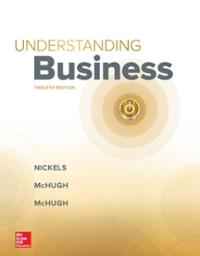Question
Question 1 [10] 1.1. If the income elasticity of demand for a product is 1.0 and if the consumer's income increases by 10%, the proportion
Question 1 [10]
1.1. If the income elasticity of demand for a product is 1.0 and if the consumer's income increases by 10%, the proportion of income spent on this product _____
A. increases by 10%.
B. increases by less than 10%.
C. stays the same.
D. decreases.
E. increases by 1%.
1.2. If income elasticity of demand for a product is zero (0), an increase in people's income will cause the demand curve to _____
A. shift to the right.
B. shift to the left.
C. not shift at all.
D. shift to the right or the left, depending on the equilibrium price.
E. become steeper.
1.3. If cross-elasticity of demand is negative, then the goods are _____
A. substitutes.
B. complements.
C. inferior.
D. necessities.
E. superior.
1.4. The equilibrium price of wine will increase if, ceteris paribus, _____
A. the supply of wine decreases.
B. wine is a normal good and income decreases.
C. there is a surplus of wine.
D. consumers are more aware of the risks of alcohol abuse.
E. all wine adverts are banned.
1.5. If one of the agents in an Edgeworth box has monopoly power and maximises profit as the sole seller, then the economic outcome is _____
A. inefficient, because the monopoly has no incentive to be technically efficient.
B. inefficient, because the monopoly produces more than the optimal amount of output.
C. inefficient, because the monopoly produces less than the optimal amount of output.
D. Both A and B are correct.
E. None of the above.
1.6. Nash equilibrium can be defined as the competitive outcome where _____
A. all firms set prices equal to average cost and all firms make economic profit.
B. each firm sets a price equal to marginal cost and all firms make economic profit.
C. each firm sets a price higher than marginal cost and all firms make economic profit.
D. each firm sets a price lower than marginal cost and all firms make economic profit.
E. firms set a price lower than average cost and all firms make economic profit.
1.7. When a product transformation curve is bowed outward, there are _____ in production.
A. economies of scope
B. economies of scale
C. diseconomies of scope
D. diseconomies of scale
E. None of the above.
1.8. Assume that a firm's production process is subject to increasing returns to scale over a broad range of outputs. Long-run average costs for this output will tend to _____
A. increase.
B. increase to a maximum and then decline.
C. fall to a minimum and then rise.
D. decline.
E. remain constant.
1.9. A monopolist will not operate along the inelastic portion of the demand curve because a monopolist will always _____
A. reduce total costs by lowering prices.
B. increase revenue by lowering prices.
C. increase revenue by raising prices.
D. reduce total costs by raising production rates.
E. Options C and D are correct.
1.10. The profit maximising rule MC = MR is followed by _____
A. both a monopolist and a perfectly competitive firm.
B. either a monopolist or a perfectly competitive firm, depending on the shape of the demand curve.
C. both a monopolist and a perfectly competitive firm, depending on the shape of the
demand curve.
D. a monopolist, but not a perfectly competitive firm.
E. a competitive firm, but not a monopolist firm.
Step by Step Solution
There are 3 Steps involved in it
Step: 1

Get Instant Access to Expert-Tailored Solutions
See step-by-step solutions with expert insights and AI powered tools for academic success
Step: 2

Step: 3

Ace Your Homework with AI
Get the answers you need in no time with our AI-driven, step-by-step assistance
Get Started


